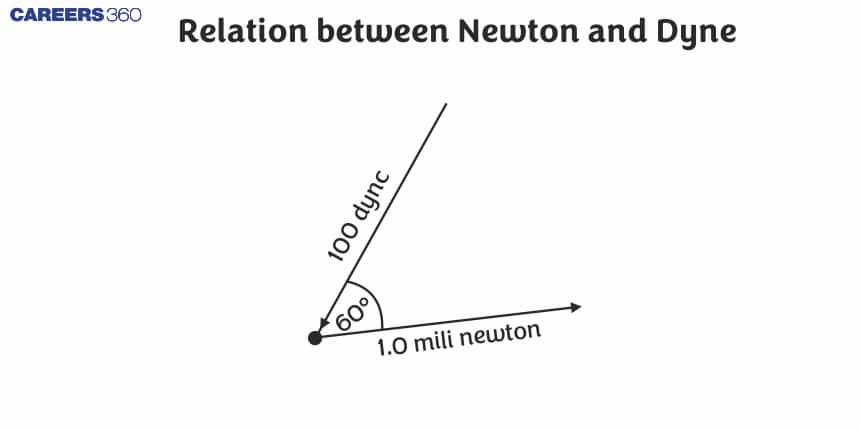Relation between Newton and Dyne
Newton and Dyne are two units to represent force but in different systems of measurement. The Newton (N) is a derived force unit in the International System of Units (SI), whereas the Dyne is a derived unit in the Centimetre-Gram-Second (CGS) system. Understanding the relationship between the two is critical in solving problems in physics and converting the measurements from one system to another. In physics, any physical quantity may be written in alternate units and those units can be interconverted by using conversion factors. For instance, 1 Newton is equivalent to 100,000 dynes. That is, a force in Newtons may be easily converted to dynes, and vice versa, so that calculations become consistent for various unit systems.
This Story also Contains
- What is Newton?
- What is Dyne?
- Difference Between Newton and Dyne
- Relation Between Newton and Dyne

Also, read
What is Newton?
Newton (N) is the SI unit of force. It is named after the famous scientist Sir Isaac Newton, who formulated the laws of motion.
One Newton is defined as the amount of force required to accelerate a mass of one kilogram by one metre per second squared.
1 Newton = Force needed to move 1 kg of mass with an acceleration of $1 \mathrm{~m} / \mathrm{s}^2$.
$
1 N=1 \mathrm{~kg} \times 1 \mathrm{~m} / \mathrm{s}^2
$
Example:
If you push a 1 kg object and it starts moving with an acceleration of $1 \mathrm{~m} / \mathrm{s}^2$, then you are applying a force of 1 Newton.
What is Dyne?
Dyne is a unit of force in the centimetre-gram-second (CGS) system of units.
It is defined as the force required to accelerate a mass of one gram by one centimetre per second squared.
1 Dyne $=$ Force needed to move 1 gram of mass with an acceleration of $1 \mathrm{~cm} / \mathrm{s}^2$
$
1 \text { dyne }=1 g \times 1 c m / s^2
$
Relation with Newton:
$
1 \mathrm{~N}=10^5 \text { dyne }
$
Example:
If you apply a small force that makes a 1 g object move faster by 1 cm every second, you are applying a force of 1 dyne.
Difference Between Newton and Dyne
| Newton (N) | Dyne |
| It is the SI unit of force. | It is the CGS unit of force. |
| 1 Newton is the force required to accelerate 1 kg mass by 1 m/s². | 1 Dyne is the force required to accelerate 1 g mass by 1 cm/s². |
| It is used in the MKS (metre–kilogram–second) system. | It is used in the CGS (centimetre–gram–second) system. |
| 1 N = 10⁵ dyne. | 1 dyne = 10⁻⁵ N. |
| It is a larger unit of force. | It is a smaller unit of force. |
| Commonly used in scientific and engineering calculations. | Commonly used in smaller-scale measurements or older systems. |
Relation Between Newton and Dyne
The relation between Newton and Dyne is based on their definitions in the SI and CGS systems of units.
1 Newton ( $\mathbf{N}$ ) = Force required to accelerate $\mathbf{1} \mathbf{~ k g}$ mass by $\mathbf{1 ~ m} / \mathbf{s}^{\mathbf{2}}$.
$\mathbf{1}$ Dyne $=$ Force required to accelerate $\mathbf{1} \mathbf{~ g}$ mass by $\mathbf{1} \mathbf{~ c m} / \mathbf{s}^{\mathbf{2}}$.
Now,
$
\begin{aligned}
& 1 \mathrm{~kg}=1000 \mathrm{~g} \\
& 1 \mathrm{~m}=100 \mathrm{~cm}
\end{aligned}
$
So,
$
\begin{gathered}
1 N=1000 g \times\left(100 c m / s^2\right) \\
1 N=10^5 d y n e
\end{gathered}
$
Related topic,
| Inertia |
| Common Forces In Mechanics |
| Equilibrium Of Concurrent Forces |
| Newton’s First Law Of Motion |
| Friction |
Frequently Asked Questions (FAQs)
The units of force are the Newton and the Dyne. A Newton is a derived unit for force followed under the International System of Units (SI Units) (SI Units). Under the Centimeter-Gram-Second (CGS) units system, a dyne is also the derived unit of force.
In the centimeter-gram-second system of physical units, a dyne is the force required to accelerate a free mass of one gramme by one centimeter per second per second. 0.00001 newton is equal to one dyne.
Definition. "The force necessary to accelerate a mass of one gramme at a velocity of one centimetre per second squared," says the dyne. The dyne can also be defined as "that force that, when operating for one second, causes a change in velocity of one centimetre per second in a mass of one gramme."
1500000 dyn = 15 N
There are 981 dynes in I gram weight.
As a result, we'll multiply by 980 to convert from gram-weight to dynes. As a result, 807 gramme weight is 807 multiplied by 980.
The international unit of force measurement is the newton (N). 1 kilogram meter per second squared equals 1 newton. In layman's terms, a newton of force is the amount of force required to accelerate an object weighing one kilogram at one meter per second per second.
The gram-force multiplied by 980.665012 equals the force in dynes.